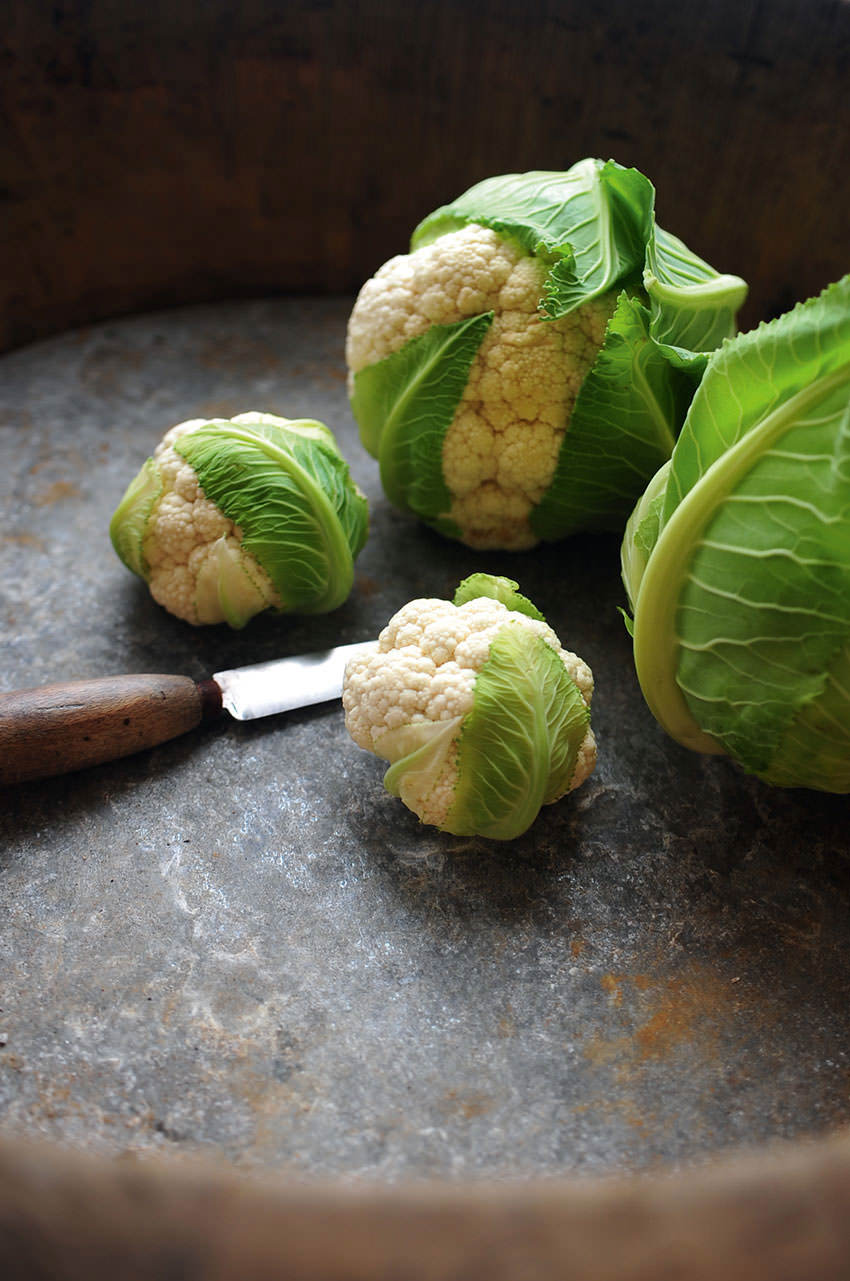Cauliflowers
These crucifers are best just after winter, when they’re packed full of vitamins – great for soups, stews and curries, says Rosemary Barron with recipes by Linda Tubby
Do cauliflowers have a season? Yes, they do. Although sold in our supermarkets all year round, this very special member of the wild cabbage family (Brassica oleracea) is at its bright and healthy best in early spring. Cauliflowers harvested at that time have had the benefit of a longer growing season (about 80 days, instead of 50 days for their summer- grown counterparts), allowing their valuable nutrients more time to develop.
The cauliflower, whose name is formed from the Latin caulis (stem) and floris (flower) is actually a cabbage bred for its flowers. The edible part of the plant, the head of tender stems and flower buds, is known as a curd. Similarly to broccoli and calabrese (close relatives), the cauliflower stores nutrients for the developing flowers at the base of the buds, so a fresh, crisp curd is packed full of vitamins and minerals. Its Latin botanical name, Brassica oleracea var botrytis (the latter part of this meaning cluster, or grape-like), is an apt description of this remarkably clever vegetable, which grows with a protective layer of leaves curled around its head.
There is disagreement over the origin of the cauliflower. Some say it was developed by 12th-century Arab gardeners, or by Romans a thousand years earlier. But the wild cabbage grew throughout the ancient eastern Mediterranean and, with its tendency to produce ‘freaks’, prototypes of the cauliflower probably originated spontaneously in different places. Curious gardeners have since, through seed selection, improved nature’s work and we are now reaping the benefits.
Medieval Italian kitchens and, later, those of Louis XIV of France, served stylish and elegant cauliflower dishes. Catherine de Medici is said to have appreciated the lovely vegetable, and to have introduced it to France to help alleviate arthritis. But its earlier French name, chou de Chypre, suggests it arrived from Cyprus – and Cypriots are, understandably, happy to claim its origin. For the past 200 years, cauliflowers have been a popular winter vegetable in northern Europe, but without its former prestige in serious kitchens. Until now. With cauliflowers piled high in our markets, this inexpensive and highly nutritious brassica is at last losing its humble status and taking its rightful place on our tables. A reputation for being bland and soggy is the fault of the cook, not of the cauliflower. Its very gentleness is the perfect foil to many fine flavours, and it takes only a few minutes to cook.
Chefs today are making imaginative dishes of cauliflower purées, grills, soups and bakes. Some have rediscovered an early Victorian preference for simmering cauliflower florets in milk lightly flavoured with mace. Meanwhile, others are exploring the vegetable’s great affinity with mushrooms, ham, spices and herbs: try small florets with saffron rice or spinach pasta and a butter and garlic sauce; or roasted, with rice, pine nuts and raisins. At El Bulli, they would serve cinnamon- perfumed cauliflower couscous, perhaps an acknowledgement of cauliflower’s North African route to Spain in the 12th century.
‘Organic’ and ‘local’ have real meaning when selecting cauliflowers: snails, aphids and caterpillars love them, so pesticides are often used and, once harvested, their nutrients and flavour dissipate quickly. Most cauliflowers are attractively white, but we also have wonderfully colourful varieties. Buy cauliflowers that smell and look fresh, with deep-green outer leaves and tight heads; avoid brown-spotted white ones, or dull-looking purple, yellow or green heads. Size doesn’t affect flavour but age does: older cauliflowers taste and smell stronger. At home, you can store a whole cauliflower in a paper bag for up to five days, but florets will keep for only a day or two.
Some of the best preparations for cauliflower can be found in kitchens of the Mediterranean: raw or lightly steamed, small florets with dips of anchovy, capers and olive oil, or hummus, are superbly healthy snacks, and a salad of grated cauliflower and carrots, with olive oil, lemon juice, sea salt and perfumed Greek oregano is packed with seasonal goodness.
Cauliflower cooks quickly: keep florets whole or cut large ones in half and simmer in a little water or steam for five minutes. After this time, cauliflower loses 20 to 30 per cent of its phytochemicals; after ten minutes, 40 per cent disappears. Where possible, cook in ways that don’t commit nutricide – in soups and stews, grilled or baked. For that Great British standby dish of cauliflower cheese – delicious, though only when prepared well and grilled until brown and bubbly – use the cooking liquor in the sauce. Best of all is the cauliflower’s wonderful ability to host spicy flavours – cumin, turmeric, chilli, ginger – making it a treasured ingredient in Indian dishes and an essential ingredient in piccalilli.
Needing space and fertile soil, but little work, cauliflowers can be a good choice for allotment gardeners. For a winter-grown crop, All The Year Round and Walcheren Winter Pilgrim have good reputations; summer-grown Gypsy has an RHS Award of Garden Merit. Or perhaps try Purple Cape, a glorious, amethyst-hued globe, or the beautiful Romanesco. Frost will destroy cauliflowers, so winter varieties grow mostly in southern Britain, and we also import large quantities from Italy and Brittany.
Richer in vitamins and minerals than any other brassica, cauliflowers are an excellent source of vitamin C, folic acid and potassium; a very good source of niacin, copper, manganese and vitamins A, K, B5 and B6; and a good source for protein, phospherous, magnesium and vitamins B2 and B3. Raw, they are even better. With winter soon drawing to an end, it’s time to enjoy the vegetable that has spent the past three months developing the nutrients we need to take us into a healthy spring

Recipes
Get Premium access to all the latest content online
Subscribe and view full print editions online... Subscribe



